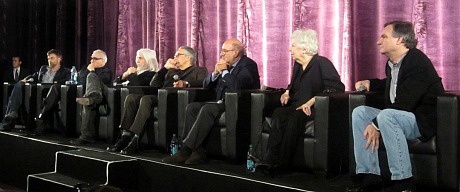Martin Scorsese‘s Hugo (Paramount. 11.23) screened this afternoon for press at the big Regal plex in downtown LA. It’s a fanciful, heavily CG-ed, 3D storybook film that plays like a “family entertainment” flick during the first two thirds to 75%, which is to say with much familiarity. But the final act, roughly the last 25 minutes, is another story.
For Hugo concludes with a great excursion into filmmaking history and the first dreammakers (particularly George Meiles, director of the 1902 A Trip To The Moon and dozens of other shorts) and film preservation and all that good movie-Catholic stuff.
This finale, aimed squarely at film dweebs and sure to sail right over the heads of most tykes and tweeners, is by far the best portion of the film, and easily worth the price of admission in itself.
Lamentably, the story of poor little Hugo Cabret (Asa Butterfield), an orphan living a hidden secret life in the guts of a Paris train station (apparently le Gare Montparnasse) in the late 1920s, occupies the bulk of the running time, and too much of this section feels rote and boilerplate. Or it did to me, at least.
I have an AFIFest event to go to in a few minutes, but here are slightly expanded versions of this afternoon’s tweets from the Regal.
Tweet #1: Too much of Hugo is done the cute way, the twee storybook way, the endearing childhood emotion way. To me the first 60% to 65% felt needlessly prolonged. Hugo runs 127 minutes, but it could and should have run 75 or 80 minutes. Okay, 90 minutes but no longer.
Tweet #2: The extended running time is due to a needlessly drawn-out relationship between an annoyingly secretive and quite inarticulate Hugo Cabret and the annoyingly secretive and inexplicably nihilistic Melies (Ben Kingsley). Melies is furious that his career has fizzled and therefore discourages any mention of his past glories — an absolutely nonsensical attitude if you know anything about what all filmmakers, failed or successful, are like.

Moderator Paul Thomas Anderson (far left) and the Hugo team (l. to r.) — director Martin Scorsese, dp Robert Richardson, composer Howard Shore, production designer Dante Ferretti, edtitor Thelma Schoonmaker, and visual effects supervisor Robert Legato.
Tweet #3: The other running-time extender is the tediously predatory pursuit of Hugo by Sasha Baron Cohen as a half doofusy, half-villainous train station cop.
Tweet #4: But once the film focuses on the legendary history of Melies and once the dawn of moviemaking in Paris in the early 1900s is recalled and recreated, Hugo is pure spirit-lifting pleasure. Finally the “cute big-eyed kid trying to survive in a Paris train station” story is more or less abandoned and the film lifts off the ground.
Tweet #5: What formerly successful filmmaker wants to hide his illustrious past? What wife of a formerly celebrated filmmaker (a woman who was the star of most of his films) wants her husband’s past success kept under wraps? After pride in craft and the respect of peers, all filmmakers live for recognition and adulation. I can’t imagine any filmmaker trying to suppress awareness of his/her past achievements, or being okay with being forgotten.
Tweet #6: I think I could have done without Sacha Baron Cohen and that Doberman altogether. And 20 or 25 fewer closeups of Butterfield’s big watery eyes and his looks of fear and hurt and bewilderment.
The post-screening discussion, moderated by Paul Thomas Anderson (The Master, There Will Be Blood), featured Scorsese, dp Robert Richardson, production designer Dante Ferretti, longtime Scorsese editor Thelma Schoonmaker, visual effects supervisor Robert Legato and composer Howard Shore.
Here’s an assessment by Hitflix/In Contention’s Kris Tapley.
